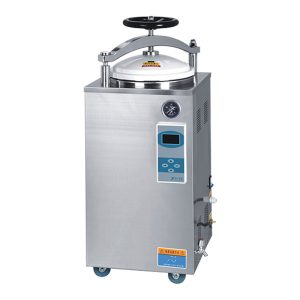1.Hand wheel door structure
2.Mechanical safety interlocking device
3.Electronic safety interlocking device
4.Computer controlled automatic cycle sterilization program
5.Digital window LCD display working status
6.Arbitrary setting of temperature (50°C-134°C)
7.Time set arbitrarily (0-9999 minutes)
8.Overpressure self-discharge 0.22 MPa
9.The machine will stop automatically after the buzzer reminder
10.Cycle time counter
11.All stainless steel material
| Technical Data | LPLS-230LD |
| Sterilizing volume | 230L |
| Chamber size | Φ600*760mm |
| Basket dimension | Φ550*220 3pcs |
| Working pressure | 0.22MPa |
| Working temperature | 134℃ |
| Temperature adjust range | 50-134℃ |
| Timer range | 0-99 min |
| Max. safety pressure | 0.23Mpa |
| Heat average | ≤±1℃ |
| Power | AC220/380V 8Kw |
| Dimension | 810×810×1500mm |
| Net/Gross Weight | 180/205 KG |
Why Autoclave is The Best Method of Sterilization
Autoclaving stands out as a highly effective method of sterilization for several reasons: 1.Comprehensive Microbial Elimination: Autoclaves use high-pressure steam, typically at temperatures above 121°C
Why is autoclaving done for 15 minutes?
The reason high-pressure sterilization typically takes 15 minutes or more is to ensure the thorough elimination of various microorganisms, including bacteria, viruses, fungi, and spores.
How an Autoclave Works
The high-pressure sterilizer functions based on a fundamental principle that leverages elevated temperature and pressure to achieve potent disinfection. Here’s a simplified explanation of its
How to clean autoclave monthly
Regularly cleaning and maintaining the high-pressure sterilizer each month is essential to ensure its proper functioning and effectiveness in disinfection. Here are the general steps













